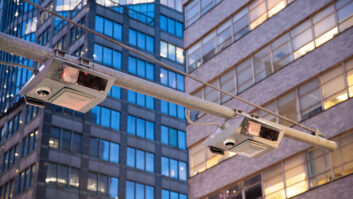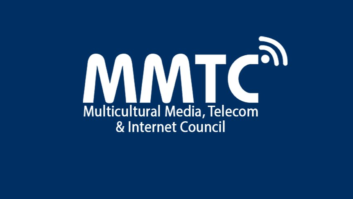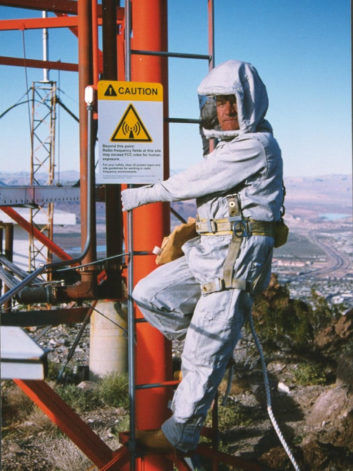
Stephen Lockwood, P.E., PMP, is president of Hatfield & Dawson Consulting Engineers.
The FCC recently adopted Docket No. 19-226, “Human Exposure to Radiofrequency Electromagnetic Fields and Reassessment of FCC Radiofrequency Exposure Limits and Policies.” These new rules became effective May 3, 2021.
This rulemaking has three main parts. The first issue was the resolution of the notice of inquiry from 2013 that asked whether radio frequency exposure limits should be changed. The second was a report and order with new rules for RF exposure. The third was a Notice of Proposed Rulemaking for additional modification to the RF exposure rules.
The major takeaways:
- There have been no changes to the existing exposure limits. This process included input from more than 1,000 commenters and participation from other federal agencies including FDA and EPA). The conclusion: “After reviewing the extensive record submitted in response to that inquiry, we find no appropriate basis for and thus decline to propose amendments to our existing limits at this time.”
- New rules have been adopted. The critical part of these rules that affect broadcasters is how to assess RF exposure compliance and how to communicate about RF hazards. New and modified facilities must comply with these rules after May 3, 2021, and existing facilities will be given until May 3, 2023 to come into compliance.
- New rules are proposed to address changing technology that would extend the frequency range from 100 GHz to 3,000 GHz, localized exposure limits and assessment methods. These issues do not pertain to broadcasting.
Evaluation of RF Exposure
The FCC has adopted new methods to determine and demonstrate compliance to replace specific outdated and inconsistent rules.
There are three sections:
- Exemption: This is for devices that are “so clearly compliant,” as demonstrated by a simple calculation to show compliance with the exposure rules, that they do not require further evaluation (i.e., operation at very low power or large distance from humans). The former term for “exemption” was “categorically excluded.” Many devices that were “categorically excluded” will now be classed as “exempt.” The former rules were based on service, whereas the new rules are more calculations-based. Broadcast equipment exempted are likely wireless microphones, wireless video feeds, Wi-Fi, cellphones and other lower power devices used in broadcast production.
- Evaluation: This category is for devices or facilities that require some demonstration such as calculations, measurements or computational modeling to demonstrate compliance. For broadcasters, there are not many changes as most facilities required and will still require analysis of RF exposure. All broadcast transmitting facilities need to analyze the facility and need to include other nearby facilities, since compliance is for the site, not just on a per-station basis.
- Mitigation: Where evaluations show a possibility that the exposure limits are exceeded, mitigation is needed to control access to RF exposure. Mitigation is accomplished by signage, access control, training or other methods to assure that exposure limits are not exceeded. Clear specifications are now given for signage and communications. All facilities that have the potential of producing areas that exceed the exposure limits must have some method of restricting exposure. All areas that exceed the public exposure limits must have some access control to restrict public access to areas that exceed the limits.
Evaluation is performed using site-specific information such as power, frequency, antenna type, physical mounting locations and distance.
These are done by using standard electromagnetic modeling, calculations using the methods laid out in OET65, or use of the FCC’s FMModel program, as appropriate.
Mitigation
The FCC has adopted four exposure categories that indicate RF exposure circumstances.
These are equivalent to the practices from “IEEE C95.7-2014 – IEEE Recommended Practice for Radio Frequency Safety Programs, 3 kHz to 300 GHz” and “IEEE C95.2-2018 ‒ IEEE Standard for Radio-Frequency Energy and Current-Flow Symbols.”
Access control, signage and training requirements generally align with existing industry best practices.
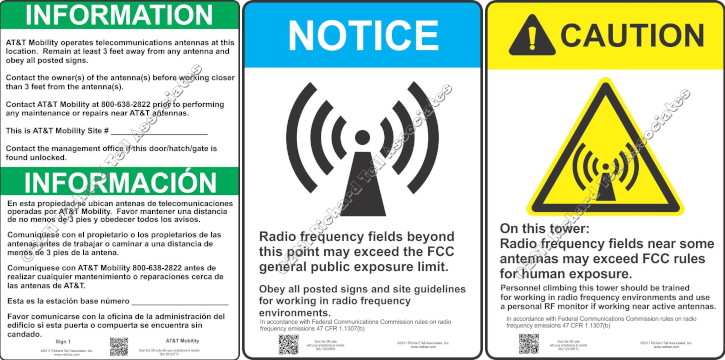
The categories from lowest exposure to highest exposure are as follows:
- Category 1: Below the General Population Limit where there is no potential of exceeding the limits. No mitigation measures are required. Optional GREEN INFORMATION sign can be posted. This sign would contain specific language for each broadcast site. Shown is an example for AT&T sites. See Fig. 1. (The images shown are courtesy Richard Tell Associates, radhaz.com.)
- Category 2: Above the General Population Limit and below Occupational Limit. Must post a BLUE NOTICE sign and limit public access to this area. See Fig. 2.
- Category 3: Above the Occupational Limit but below 10x the Occupational Limit. Must post a YELLOW CAUTION sign and limit access to both workers and the public. See Fig. 3.
- Category 4: Above 10x the Occupational limit. The ORANGE sign shown in Fig. 4 is required, and limit all access. Also must post a RED WARNING sign as discussed below.
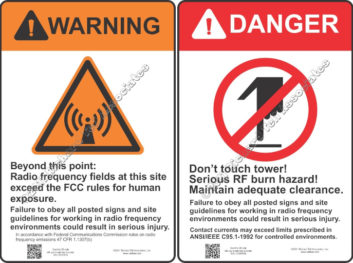
A RED DANGER sign must be posted where immediate and serious injury potential exists, regardless of category. An example of this would be AM tower bases, where shock and burn hazards are present. See Figure 5.
Additional Mitigation Measures
- Category 2 (NOTICE): Signs, positive access controls such as locked doors, ladder cages, fences, on-site building security — appropriate training with supervision of transient persons.
- Category 3 (CAUTION): Signs, engineering controls, indicators such as chains, railings, paint, maps. Appropriate training, use of time-averaging, or personal protective equipment.
- Category 4 (WARNING): Signs, restricted access, power reduction, ceasing operation with lockout/tagout on controls.
The following information must be communicated:
- All these signs must include the RF energy advisory symbol. See Fig. 6.
- A description of the RF source (e.g., types of facility and transmitting antennas)
- Behavior necessary to avoid overexposure (e.g., access limits)
- Up-to-date contact information (e.g., monitored phone number or email address connected to someone with authority and capability to provide a prompt response).
From the FCC
As part of this process, the FCC Office of Engineering Technology is revising OET Bulletin No. 65, “Evaluating Compliance with FCC Guidelines for Human Exposure to Radio frequency Electromagnetic Fields.”
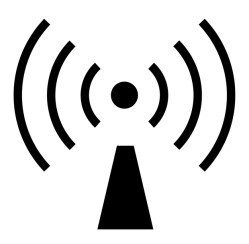
This document provides the necessary methods to calculate RF exposure. The FCC provides the tool of FMModel to evaluate RF exposure from FM antennas quickly. All new and modified facilities must comply with the new rules. All other licensees must come into compliance by May 3, 2023. A review of the evaluation process and mitigation methods must be done for existing facilities to confirm compliance.
Some Observations
We believe that the vast majority of broadcast sites comply with the FCC rules.
In most of the nation, on-tower work is the situation where RF exposure limits may be exceeded. The best practice is to cease operations when on-tower maintenance is being performed near the antennas.
The more dangerous issue for tower worker safety is the gravity field, and removing the RF field (which, unlike the gravity field, has an off switch!) is the better approach.
For multiuser sites, maintenance requires coordination between licenses and the tower crews.
Docket No. 19-226 specifically warns against over-signage. We note that many sites have conflicting signs, and many licensees have posted all available RF signs.
RF signs and other hazard signs such as HIGH VOLTAGE have been used in place of NO TRESPASSING signs, warning of hazards that do not exist. This is inappropriate as warning should only be given for real hazards — something about a boy crying wolf.
To comply with a misunderstanding of the RF exposure conditions and rules, some licensees have ordered all of the signs in the catalog and posted them all in hopes that one will be correct. We have noted that many sites have all of the signs posted. Some analysis is required for determining the correct signage for each site.
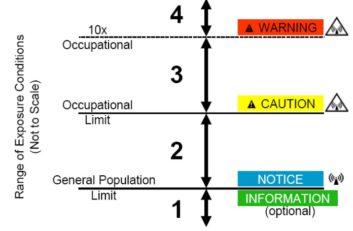
Site evaluation now mainly occurs during the licensing process or license renewal.
The first step in this process is to review what was represented to the FCC and ensure that it conforms with reality. Has the antenna been changed? Have new facilities been added to the tower? On an adjacent tower?
The most troublesome RF exposure sites are mountaintop sites that use short towers. Many of these sites present RF exposure environments that are above the FCC limits. Licensee must perform analysis to assure these areas are appropriately signed and managed.
Many sites have outdated signs or signs that are inappropriate. All signage at RF sites must be reviewed and revised to comply with these new rules. For many sites, the signs have been posted for 20 or more years and have faded.
Some examples of outdated and inappropriate signs are shown in Figs. 8 and 9.
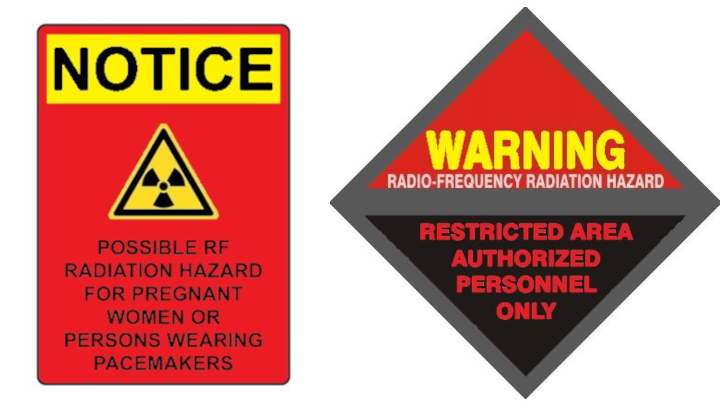
While these newly-enacted RFR rules don’t change the exposure limits for the frequencies in which broadcasters operate, they still affect broadcasters.
Going forward, we will have to perform new evaluations and update our signage. For existing facilities, the time to prepare for this is now, long before the 2023 deadline.










